KitchenAid KRMF706ESS01, KRMF706ESS00, KRMF706EBS01, KRMF706EBS00, KRMF606ESS01 Owner’s Manual
...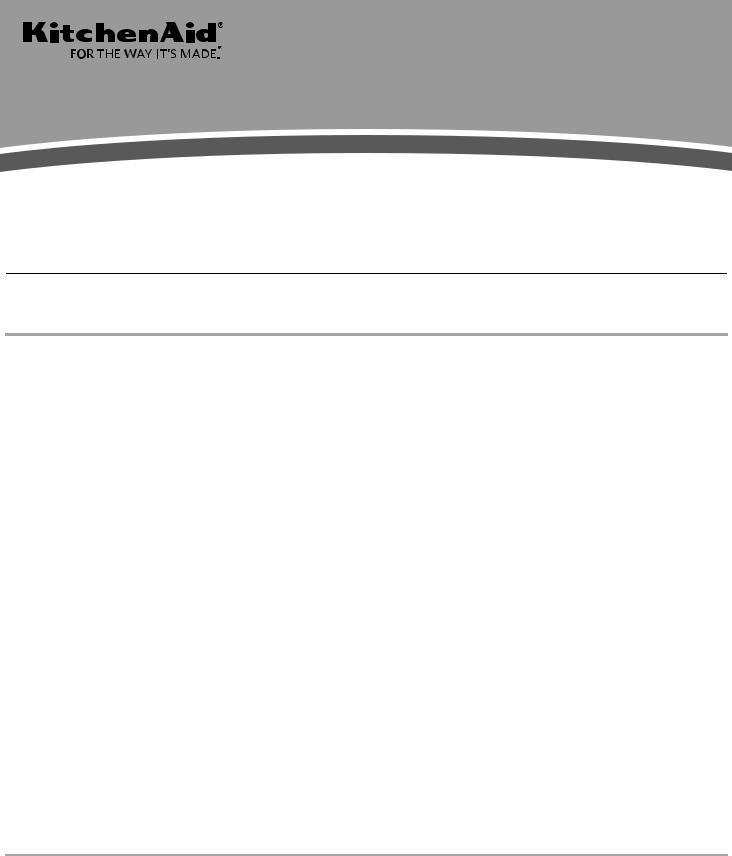
REFRIGERATOR USER INSTRUCTIONS
THANK YOU for purchasing this high-quality product. Register your new refrigerator at www.kitchenaid.com. In Canada, register your refrigerator at www.kitchenaid.ca.
For future reference, please make a note of your product model and serial numbers. These can be located on the inside wall of the refrigerator compartment.
Model Number ___________________________________________ |
Serial Number____________________________________________ |
Para obtener acceso a “Instrucciones para el usuario del refrigerador” en español, o para obtener información adicional acerca de su producto, visite: www.kitchenaid.com.
Necesitará su número de modelo y de serie, ubicado en el interior del compartimiento del refrigerador.
Table of Contents / Table des matières
REFRIGERATOR SAFETY........................................................ |
2 |
INSTALLATION INSTRUCTIONS............................................. |
3 |
Unpack the Refrigerator ......................................................... |
3 |
Remove and Replace Refrigerator Doors .............................. |
4 |
Remove and Replace Drawer Fronts ..................................... |
7 |
Align Doors and Drawers........................................................ |
9 |
Location Requirements ........................................................ |
11 |
Electrical Requirements........................................................ |
12 |
Water Supply Requirements................................................. |
12 |
Connect the Water Supply ................................................... |
12 |
Handle Installation and Removal.......................................... |
14 |
Refrigerator Leveling and Door Closing ............................... |
15 |
FILTERS AND ACCESSORIES............................................... |
16 |
Water Filtration System ........................................................ |
16 |
Install Air Filter....................................................................... |
17 |
Install Produce Preserver ..................................................... |
18 |
Accessories........................................................................... |
19 |
REFRIGERATOR USE............................................................. |
19 |
Opening and Closing Doors ................................................. |
19 |
Using the Controls................................................................ |
19 |
Refrigerator Features............................................................ |
22 |
Water and Ice Dispensers .................................................... |
23 |
Ice Maker and Ice Storage Bin............................................. |
26 |
REFRIGERATOR CARE.......................................................... |
27 |
Cleaning ................................................................................ |
27 |
Lights .................................................................................... |
28 |
Vacation and Moving Care ................................................... |
28 |
TROUBLESHOOTING............................................................. |
29 |
PERFORMANCE DATA SHEET ............................................. |
34 |
WARRANTY............................................................................. |
35 |
SÉCURITÉ DU RÉFRIGÉRATEUR......................................... |
36 |
INSTRUCTIONS D’INSTALLATION....................................... |
37 |
Déballage du réfrigérateur .................................................... |
37 |
Retrait et réinstallation des portes du réfrigérateur.............. |
38 |
Retrait et réinstallation de l’avant des tiroirs ........................ |
41 |
Alignement des portes et des tiroirs..................................... |
43 |
Exigences d’emplacement ................................................... |
46 |
Spécifications électriques..................................................... |
46 |
Spécifications de l’alimentation en eau................................ |
47 |
Raccordement à la canalisation d’eau ................................. |
47 |
Installation et retrait des poignées........................................ |
49 |
Nivellement du réfrigérateur et fermeture de la porte .......... |
50 |
FILTRES ET ACCESSOIRES .................................................. |
51 |
Système de filtration d’eau................................................... |
51 |
Installation du filtre à air........................................................ |
52 |
Installation du conservateur pour produits frais................... |
53 |
Accessoires........................................................................... |
53 |
UTILISATION DU RÉFRIGÉRATEUR .................................... |
54 |
Ouverture et fermeture des portes ....................................... |
54 |
Utilisation des commandes .................................................. |
54 |
Caractéristiques du réfrigérateur.......................................... |
57 |
Distributeurs d’eau et de glaçons......................................... |
59 |
Machine à glaçons et bac de rangement |
|
pour les glaçons.................................................................... |
62 |
ENTRETIEN DU RÉFRIGÉRATEUR....................................... |
64 |
Nettoyage.............................................................................. |
64 |
Lampes ................................................................................. |
65 |
Précautions à prendre pour les vacances |
|
ou le déménagement ............................................................ |
65 |
DÉPANNAGE........................................................................... |
66 |
FEUILLE DE DONNÉES SUR LA PERFORMANCE.............. |
73 |
GARANTIE ............................................................................... |
74 |
W10730912C
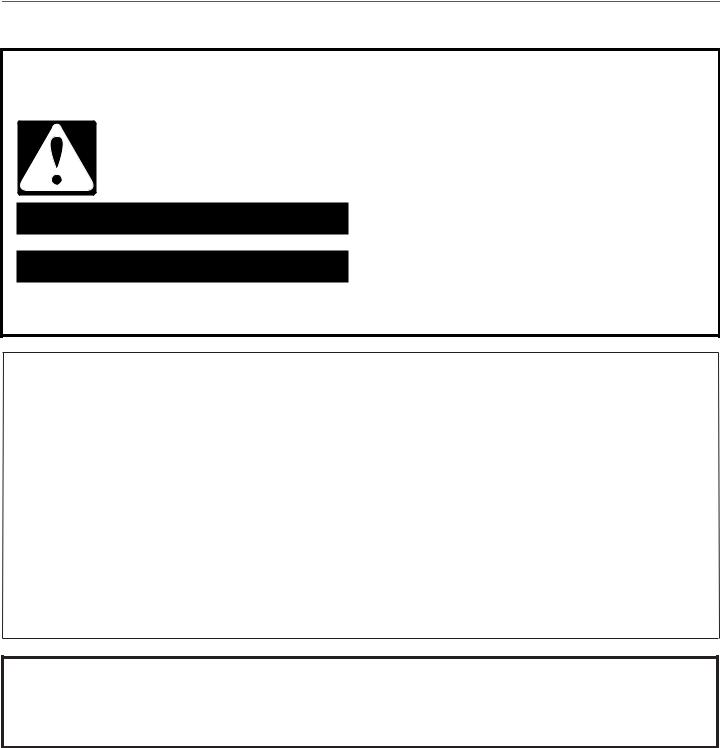
REFRIGERATOR SAFETY
Your safety and the safety of others are very important.
We have provided many important safety messages in this manual and on your appliance. Always read and obey all safety messages.
This is the safety alert symbol.
This symbol alerts you to potential hazards that can kill or hurt you and others.
All safety messages will follow the safety alert symbol and either the word “DANGER” or “WARNING.” These words mean:
 DANGER
DANGER
 WARNING
WARNING
You can be killed or seriously injured if you don't immediately follow instructions.
You can be killed or seriously injured if you don't follow instructions.
All safety messages will tell you what the potential hazard is, tell you how to reduce the chance of injury, and tell you what can happen if the instructions are not followed.
IMPORTANT SAFETY INSTRUCTIONS
WARNING: To reduce the risk of fire, electric shock, or injury when using your refrigerator, follow these basic precautions:
■Plug into a grounded 3 prong outlet.
■Do not remove ground prong.
■Do not use an adapter.
■Do not use an extension cord.
■Disconnect power before servicing.
■Replace all parts and panels before operating.
■Remove doors from your old refrigerator.
■Connect to a potable water supply only.
■Use nonflammable cleaner.
■Keep flammable materials and vapors, such as gasoline, away from refrigerator.
■Use two or more people to move and install refrigerator.
■Disconnect power before installing ice maker (on ice maker kit ready models only).
■Use a sturdy glass when dispensing ice (on some models).
■Do not hit the refrigerator glass doors (on some models).
■This appliance is not intended for use by persons (including children) with reduced physical, sensory or mental capabilities, or lack of experience and knowledge, unless they have been given supervision or instruction concerning use of the appliance by a person responsible for their safety.
■Children should be supervised to ensure that they do not play with the appliance.
SAVE THESE INSTRUCTIONS
State of California Proposition 65 Warnings:
WARNING: This product contains one or more chemicals known to the State of California to cause cancer.
WARNING: This product contains one or more chemicals known to the State of California to cause birth defects or other reproductive harm.
2

Proper Disposal of Your Old Refrigerator
WARNING
Suffocation Hazard
Remove doors from your old refrigerator.
Failure to do so can result in death or brain damage.
IMPORTANT: Child entrapment and suffocation are not problems of the past. Junked or abandoned refrigerators are still dangerous
– even if they will sit for “just a few days.” If you are getting rid of your old refrigerator, please follow these instructions to help prevent accidents.
Before You Throw Away Your Old Refrigerator or Freezer:
■Take off the doors.
■Leave the shelves in place so that children may not easily climb inside.
Important information to know about disposal of refrigerants:
Dispose of refrigerator in accordance with Federal and Local regulations. Refrigerants must be evacuated by a licensed, EPA certified refrigerant technician in accordance with established procedures.
INSTALLATION INSTRUCTIONS
Unpack the Refrigerator
WARNING
Excessive Weight Hazard
Use two or more people to move and install refrigerator.
Failure to do so can result in back or other injury.
Remove the Packaging
When Moving Your Refrigerator:
Your refrigerator is heavy. When moving the refrigerator for cleaning or service, be sure to cover the floor with cardboard or hardboard to avoid floor damage. Always pull the refrigerator straight out when moving it. Do not wiggle or “walk” the refrigerator when trying to move it, as floor damage could occur.
Clean Before Using
■Remove tape and glue residue from surfaces before turning on the refrigerator. Rub a small amount of liquid dish soap over the adhesive with your fingers. Wipe with warm water and dry.
■Do not use sharp instruments, rubbing alcohol, flammable fluids, or abrasive cleaners to remove tape or glue. These products can damage the surface of your refrigerator. For more information, see “Refrigerator Safety.”
■Dispose of/recycle all packaging materials.
After you remove all of the packaging materials, clean the inside of your refrigerator before using it. See the cleaning instructions in “Refrigerator Care.”
Important information to know about glass shelves and covers:
Do not clean glass shelves or covers with warm water when they are cold. Shelves and covers may break if exposed to sudden temperature changes or impact, such as bumping. Tempered glass is designed to shatter into many small, pebble-size pieces. This is normal. Glass shelves and covers are heavy. Use both hands when removing them to avoid dropping.
3
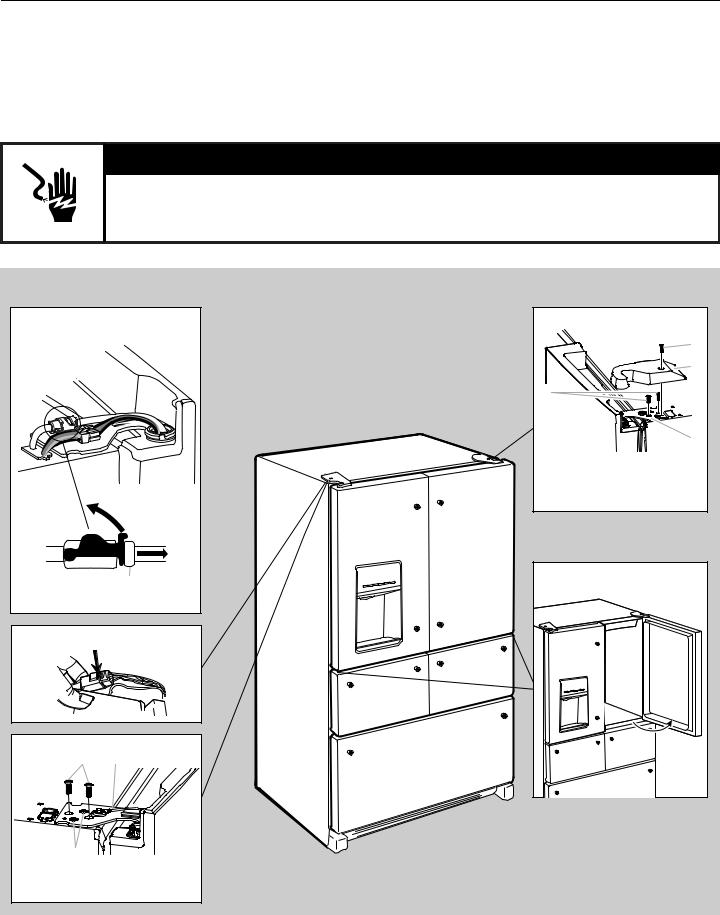
Remove and Replace Refrigerator Doors
NOTE: Measure the width of your door opening to see whether or not you need to remove the refrigerator doors to move the refrigerator into your home. If door removal is necessary, see the following instructions.
IMPORTANT: If the refrigerator was previously installed and you are moving it out of the home, before you begin, turn the refrigerator control OFF. Unplug the refrigerator or disconnect power. Remove food and adjustable door or utility bins from doors.
Gather the required tools and read all instructions before removing doors. TOOLS NEEDED: ³⁄" hex key and a #2 Phillips screwdriver
 WARNING
WARNING
Electrical Shock Hazard
Disconnect power before removing doors.
Failure to do so can result in death or electrical shock.
Door Removal and Replacement
Water Dispenser |
Tubing Connection |
A |
A. Outer Ring |
Wiring Plug
Top Left Hinge |
|
A |
B |
C |
|
A. ³⁄" Internal Hex-Head Screws |
|
B. Ground Wire (Do Not Remove) |
|
C. Do Not Remove Screws |
|
Top Right Hinge |
B |
C |
A |
D |
A. ³⁄" Internal Hex-Head Screws |
B. Hinge Cover Screw |
C. Top Hinge Cover |
D. Top Hinge |
Door at 90˚ Angle |
to Cabinet |
90˚ |
4
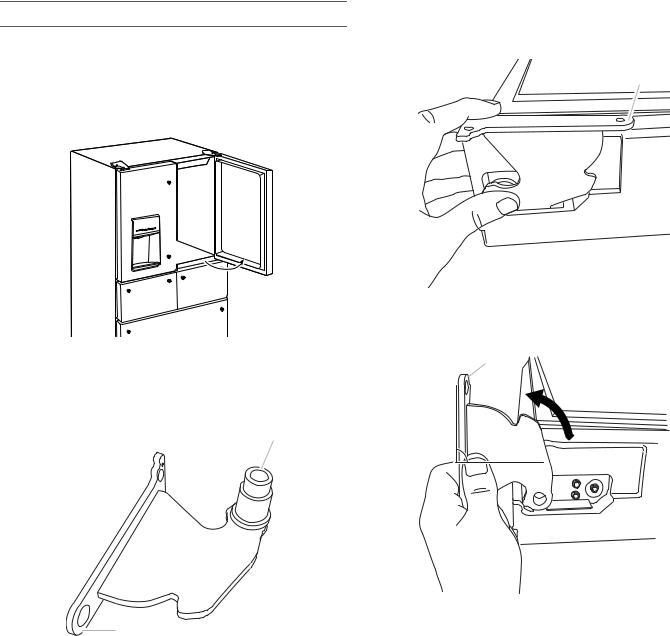
Bottom Door Hinge
For your convenience, the refrigerator doors have bottom hinges with door closers. These closers allow the doors to swing fully closed with just a gentle push.
IMPORTANT: So that the closers feature will operate properly, the doors must be removed only when open to a 90° angle to the front of the cabinet. If one or both doors were not at a 90° angle when removed, the bottom door hinge must be reset.
3.Insert the bottom hinge and bushing into the corresponding slot in the bottom of the door.
NOTE: Make sure that the base of the hinge is parallel to the bottom of the door.
A
90˚
Reset the Door Hinge
1.Lift the door from the bottom hinge pin and place it on a flat surface.
2.Using a driver with a #2 square bit, remove the bottom hinge with the bushing from the cabinet.
A
B
A.Bushing
B.Hinge base
A.Hinge base parallel to the bottom edge of the door
4.Turn the hinge until the hinge base is at a 90° angle to the bottom edge of the door.
 A
A
90°
A.Hinge base turned to a 90° angle with the bottom edge of the door
5.Remove the hinge from the door. Using a driver with a
#2 square bit, reattach the bottom hinge to the refrigerator cabinet.
6.The hinge is now reset and prepared for the door to be replaced. See “Replace Refrigerator Doors” later in this section.
5
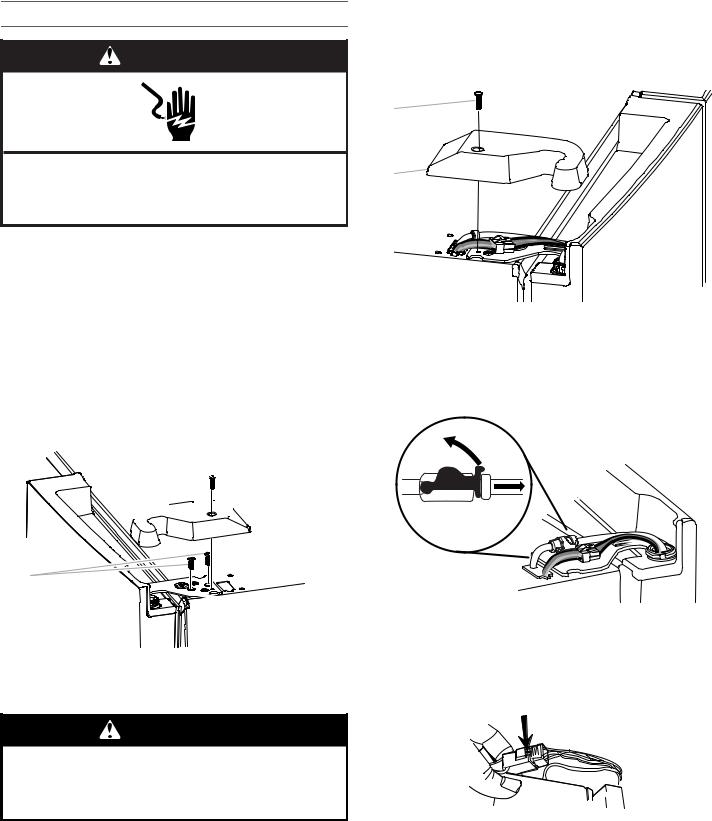
Remove Refrigerator Doors
WARNING
Hazard
Disconnect power before removing doors.
Failure to do so can result in death or electrical shock.
Remove Right-Hand Refrigerator Door
1.Unplug refrigerator or disconnect power.
2.Keep the refrigerator doors closed until you are ready to lift them free from the cabinet.
NOTE: Provide additional support for the refrigerator door while the hinges are being removed. Do not depend on the door gasket magnets to hold the door in place while you are working.
3.Using a Phillips screwdriver, remove the cover from the top hinge.
4.Using the ³⁄" hex key, remove the two internal hex-head screws from the top hinge and set aside.
NOTE: Do not remove the two locator screws. These screws will help you align the hinge when you replace the door.

 A
A




 B
B
C
 D
D
A. Top hinge cover screw |
C. ³⁄" Internal hex-head screws |
B. Top hinge cover |
D. Top hinge |
Remove Left-Hand Refrigerator Door
IMPORTANT: The tubing and wiring for the water dispenser run through the left-hand door hinge, so they must be disconnected before removing the door.
1.Using a Phillips screwdriver, remove the cover from the top hinge.
A
B
A. Top hinge cover screw |
B. Top hinge cover |
2.Disconnect the water dispenser tubing located on top of the door hinge by firmly pulling up on the clasp. Then, pull the tubing out of the fitting.
NOTE: The water dispenser tubing remains attached to the left-hand refrigerator door.
3.Disconnect the wiring plug located on top of the door hinge.
■Grasp each side of the wiring plug. With your left thumb, press down to release the catch and pull the sections of the plug apart.
NOTE: Do not remove the green, ground wire. It should remain attached to the door hinge.
WARNING
Excessive Weight Hazard
Use two or more people to lift the refrigerator door. Failure to do so can result in back or other injury.
5.Open the door until it is at a 90° angle to the front of the cabinet.
6.Lift the refrigerator door from the bottom hinge pin. The top hinge will come away with the door.
4.Using the ³⁄" hex key wrench, remove the two internal hex-head screws from the top hinge and set aside.
6
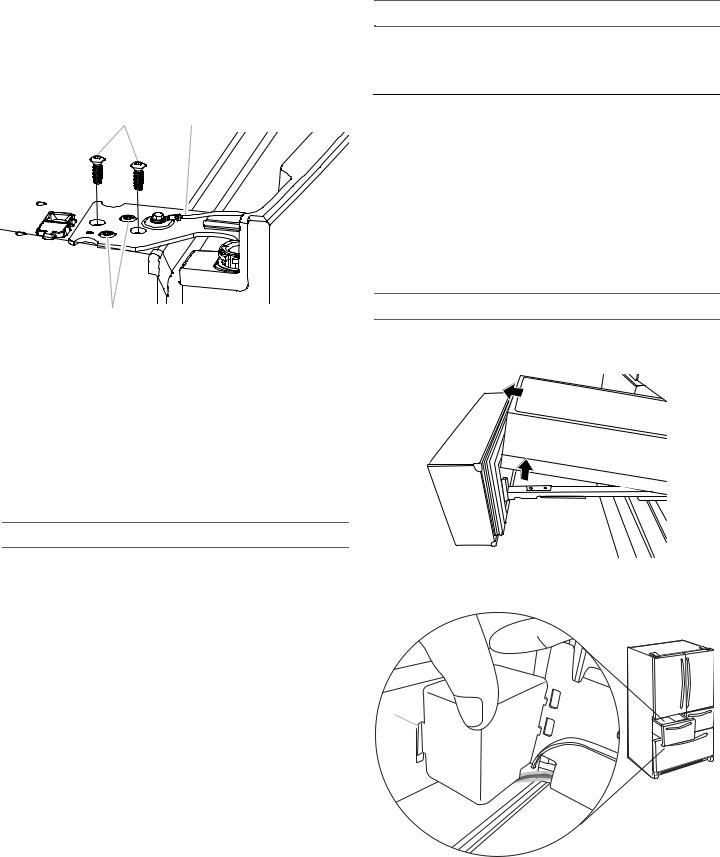
NOTES:
■Provide additional support for the refrigerator door while the hinges are being removed. Do not depend on the door gasket magnets to hold the door in place while you are working.
■Do not remove the two locator screws. These screws will help you align the hinge when you replace the door.
A B
C
A. ³⁄" Internal hex-head screws |
C. Locator screws |
B. Ground wire (Do not remove) |
(Do not remove) |
5.Open the door until it is at a 90° angle to the front of the cabinet.
6.Lift the refrigerator door from the bottom hinge pin. The top hinge will come away with the door.
NOTE: It may not be necessary to remove the bottom hinges and brake feet assemblies to move the refrigerator through a doorway.
■Only if necessary, use a driver with a #2 square bit tip to remove the bottom hinges and a ³⁄" nut driver to remove the brake feet screws.
Replace Refrigerator Doors
IMPORTANT: To avoid damage to the refrigerator doors, they must be replaced at a 90° angle to the front of the cabinet. You should not have to force the door onto the hinge if it is at the correct angle.
Replace Right-Hand Refrigerator Door
1.Holding the right-hand door at a 90° angle to the front of the cabinet, set the door onto the bottom hinge pin.
2.Insert the top hinge pin into the open hole in the top of the refrigerator door.
3.Using the two ³⁄" internal hex-head screws, fasten the hinge to the cabinet. Do not tighten the screws completely.
Replace Left-Hand Refrigerator Door
IMPORTANT: Do not intertwine the water tubing and wiring bundles when reconnecting them.
1.Holding the left-hand door at a 90° angle to the front of the cabinet, set the door onto the bottom hinge pin.
2.Using the two ³⁄" internal hex-head screws, fasten the hinge to the cabinet. Do not tighten the screws completely.
3.Reconnect the water dispenser tubing.
Style 1 - Insert the tubing into the fitting until it stops and the outer ring is touching the face of fitting.
Style 2 - Insert the tubing firmly into the fitting until it stops. Close the clasp around the tubing. The clasp snaps into place between the fitting and the collar.
4.Reconnect the electrical wiring.
■ Push together the two sections of the wiring plug.
Final Steps
1.Completely tighten the four internal hex-head screws (two on the right-hand door hinge and two on the left-hand door hinge).
2.Replace both top hinge covers.
Remove and Replace Drawer Fronts
Depending on the width of your door opening, it may be necessary to remove the drawer fronts to move the refrigerator into your home.
IMPORTANT:
■If the refrigerator was previously installed and you are moving it out of the home, before you begin, turn the refrigerator control OFF, and unplug the refrigerator or disconnect power. Remove food from the drawers.
■Two people may be required to remove and replace the drawer fronts.
Tools Needed: Flat-blade screwdriver
Refrigerated Drawers
Remove the Drawer Fronts
1.Open the drawer to its full extension. Grasp the sides of the interior bin, and then lift up and out to remove.
2.Left-hand drawer only: Remove the wiring connection cover. Press in on the side of the cover to release the tab from the slot, and then pull the cover away from the bracket.
A
B 
A.Cover tab
B.Wiring connection cover
7
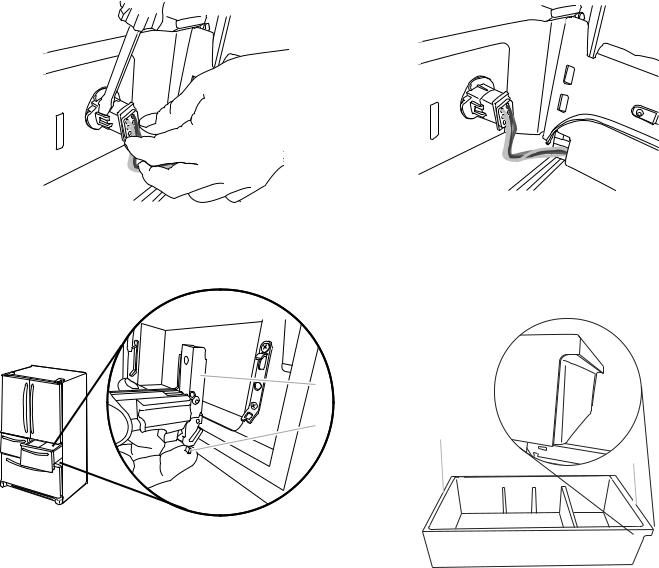
3.Left-hand drawer only: Disconnect the wiring.
NOTE: The drawer front of the left-hand refrigerated drawer is connected to the temperature control by wires running underneath the drawer glide. Before removing the drawer front, the wires must be disconnected.
■On one side of the wiring connector, insert the screwdriver blade between the connector tab and the connector to release. Repeat for the opposite side. Pull the wiring connector apart.
4.Remove the drawer front.
■Push up on the lever at the bottom of the drawer glide bracket to release the drawer front from the bracket.
■Lift the drawer front up and off the drawer glide brackets.
3.Left-hand drawer only: Reconnect wiring.
■Align the two ends of the wiring connector and push them together until you hear a “click” sound and feel the tabs snap into place on the connector.
■Gently pull on the wiring connection to ensure the wiring connection is completely seated. Replace the wiring cover.
NOTE: The wiring connection must be complete for the drawer temperature control to operate.
4.Left-hand drawer only: Replace the wiring connection cover.
5.Replace the drawer bins onto the drawer glides with the rear side of the bin facing the back of the refrigerator as shown.
IMPORTANT: The Door Ajar alarm will sound if the interior drawer bins are not replaced correctly. The bins are designed with a specific front and rear. They must be placed into the drawers, as shown, so that the refrigerated drawers will close and operate properly.
A |
|
B |
B |
|
|
|
A |
A. Drawer glide bracket |
B. Release lever |
5. Slide the drawer glides back into the refrigerator.
Replace the Drawer Fronts
1.Pull out the drawer glides until they are fully extended.
2.Push up on the lever at the bottom of the drawer glide bracket to open. Insert the drawer front bracket into the drawer glide bracket and release the lever.
NOTE: It helps if one person holds the drawer glides steady while another person aligns the drawer front and connects the brackets.
A.Faces back of refrigerator (insert first)
B.Faces front of refrigerator
8
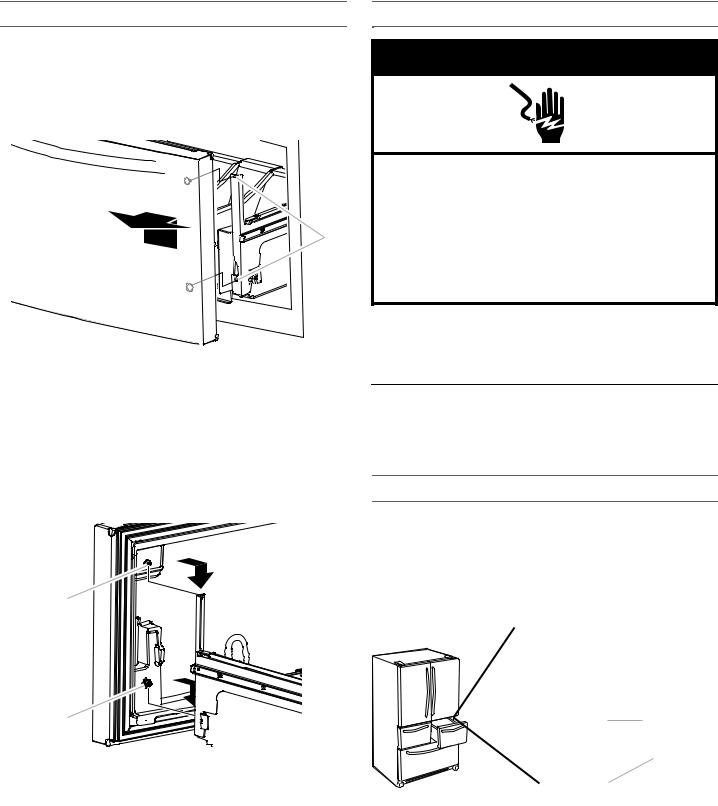
Freezer Drawer
Remove Drawer Front
1.Open the freezer drawer to its full extension.
2.Loosen the two top screws that fasten the drawer front to the drawer glides. The two screws (one on the left-hand side and one on the right-hand side) are located inside the drawer front.
3.Lift up on the drawer front to release the plastic studs from the drawer glide bracket slots.
A
A.Drawer glide bracket slots
4.Slide the drawer glides back into the freezer.
Replace Drawer Front
1.Pull out the freezer drawer glides to their full extension.
2.Holding the drawer front by its sides, align the two plastic studs, located at the bottom, inside the drawer front, with the drawer glide bracket slots.
NOTE: It helps if one person holds the drawer glides steady while another person aligns the drawer front and inserts the studs into the slots.
A
B
A.Drawer front screw
B.Drawer front plastic stud
3.Replace and tighten the two screws at the top of the drawer front (one on the left-hand side and one on the right-hand side).
Final Steps
 WARNING
WARNING
Electrical Shock Hazard
Plug into a grounded 3 prong outlet.
Do not remove ground prong.
Do not use an adapter.
Do not use an extension cord.
Failure to follow these instructions can result in death, fire, or electrical shock.
1.Plug into a grounded 3 prong outlet.
2.Reset the controls. See “Using the Control(s)” and “Temperature Controlled Exterior Drawer.”
3.Return all removable parts and the food to the drawers.
Align Doors and Drawers
Once the doors and drawer fronts are replaced on the refrigerator, you may notice that the doors appear angled or that they are no longer level. Both the refrigerator doors and refrigerated drawers are adjustable.
Align Refrigerator Door
Tools Provided: ¹⁄ " hex key
1.Keeping both refrigerator doors closed, pull out the right-hand refrigerated drawer. Locate the bottom hinge pin of the refrigerator door. The alignment screw is inside the bottom hinge pin.
A.Bottom hinge pin
B.Turn to the right to raise.
A 
B
C 
D
C.Turn to the left to lower.
D.¹⁄" Hex key
2.Insert the short end of the ¹⁄ " hex key (packed with the Door Handle Installation Instructions) into the bottom hinge pin until it is fully engaged in the alignment screw.
■To raise the door, turn the hex key to the right.
■To lower the door, turn the hex key to the left.
3.Continue to turn the alignment screw until the doors are aligned.
9
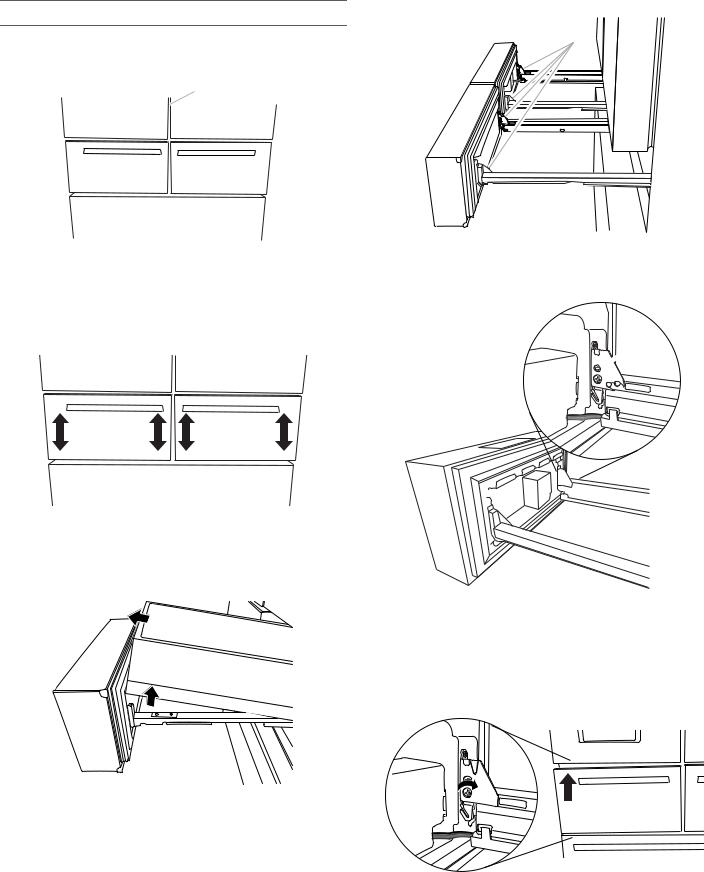
Align Refrigerated Drawer Fronts
When the drawer fronts are aligned, the width of the vertical space
(A) between the refrigerator doors (B) and the drawer fronts (C) is the same thickness, and the drawers appear level.
A
B 
 B
B
C
 C
C
3. Locate the drawer glide brackets (A).
A
Aligning the drawer fronts is a two-step process. The first step is to adjust the drawer fronts up and down. The second step shifts the drawer fronts from side to side. Visually inspect the refrigerator for alignment and adjust the drawer fronts as needed.
Step 1 - Adjust the Drawer Fronts Up/Down
IMPORTANT: Each refrigerated drawer can be adjusted up and down on both the left and the right sides.
Tools Needed: Phillips screwdriver
1.With the drawers closed, identify the drawer front that needs to be raised or lowered.
2.Open the drawer to its full extension. Grasp the sides of the interior bin, and then lift it up and out to remove.
A.Drawer glide brackets
4.Insert the Phillips screwdriver into screw (A) and turn counterclockwise to loosen the drawer front.
A
 B
B
A.Tightening screw
B.Adjusting screw
5.Insert the Phillips screwdriver into screw (B) to adjust the drawer front.
IMPORTANT: The direction you turn screw (B) depends on which side of the drawer you are adjusting.
Left-Hand Side Drawer Glide
■To raise the drawer front, turn screw (B) clockwise.
■To lower the drawer front, turn screw (B) counterclockwise.
10
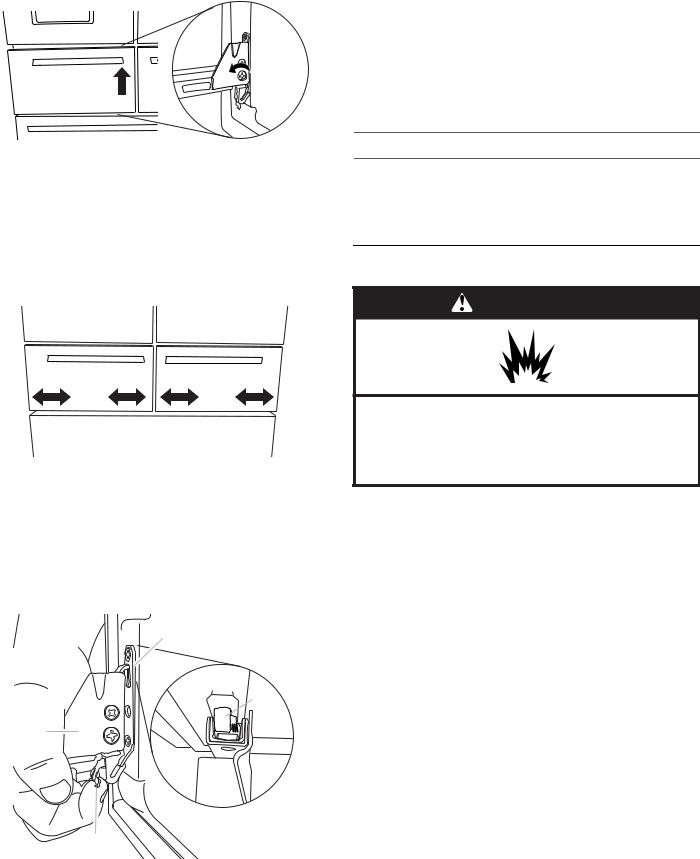
Right-Hand Side Drawer Glide
■To raise the drawer front, turn screw (B) counterclockwise.
■To lower the drawer front, turn screw (B) clockwise.
6.Insert the Phillips screwdriver into screw (A), and turn clockwise to tighten the drawer front.
7.Close the refrigerated drawer to check the alignment. Repeat steps 2 through 6 until the drawer fronts are level.
Step 2 - Adjust the Drawer Fronts Side-to-Side
IMPORTANT: Each refrigerated drawer can be adjusted side-to-side on both the left and right side.
1.With the drawers closed, identify the drawer that is not aligned.
2.Open the drawer to its full extension. Grasp the sides of the interior bin, and then lift it up and out to remove. (See step 1 for further details.)
3.Locate the drawer glide brackets. (See step 1 for further details.)
4.Starting with the glide bracket closest to the vertical gap, press and hold the release lever (C) up. With your other hand, lift the door clip (A) from the bracket (B).
A
 A
A
B
 B
B
C
A.Drawer front clip
B.Drawer glide bracket
C.Release lever
5.Reposition the clip (A) onto the glide bracket (B) in the direction you want to move the drawer front. Make sure that the glide bracket is vertically level.
6.Release the lever (C) to lock the glide bracket into position.
7.Repeat steps 3 through 6 for the other side of the drawer front.
NOTE: Adjust the clip (A) on the top of the second glide bracket (B) so that it is in the same position as the side you adjusted first.
8.Close the drawer and visually inspect the gap. Repeat steps 2 though 7 until the drawer fronts are aligned.
Final Steps
1.Replace the interior drawer bins.
NOTE: The bins must be placed into the drawers correctly so that the refrigerated drawers will close and operate properly. See “Remove and Replace Drawer Fronts.”
2.Close the refrigerated drawers.
Location Requirements
WARNING
Explosion Hazard
Keep flammable materials and vapors, such as gasoline, away from refrigerator.
Failure to do so can result in death, explosion, or fire.
IMPORTANT: This refrigerator is designed for indoor, household use only.
To ensure proper ventilation for your refrigerator, allow for a ¹⁄ " (1.25 cm) of space on each side and at the top. Allow for a
1" (2.54 cm) space behind the refrigerator. If your refrigerator has an ice maker, allow extra space at the back for the water line connections. When installing your refrigerator next to a fixed wall, leave a 3³⁄ " (9.5 cm) minimum space between the refrigerator and wall to allow the door to swing open.
11
